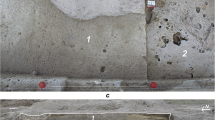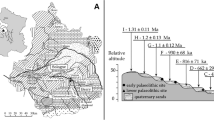Abstract
The most precise method for reconstructing operational chains (chaîne opératoire) is the refitting of stone artefacts. Unfortunately, the sequences for forming a typical Szeletian artefact—a leaf point—were missing for a long time. Finds from the multilayer open-air site of Moravský Krumlov IV (Czech Republic) brought a unique opportunity to study Szeletian technology through refittings. The excavations of this site uncovered an in situ horizon in the uppermost archaeological layer 0 in sector IV-3 that has been classified as a workshop. On the basis of both technology and dating, the finds are related to the Szeletian. Spatial distribution of bifacial artefact refittings shows that pieces were produced in two distinct spots within the excavated area. An analysis of their deposition indicated an in situ position, and therefore, results of the technological analysis can be understood as significant. Refittings and surface morphological analyses demonstrate a specific manner of leaf point production based primarily on achieving a maximum reduction in thickness and a minimum reduction of their length and, especially, width. Although incomplete and unsuccessful artefacts are reminiscent of the Middle Palaeolithic Micoquian backed knives, the general production strategy tended towards the manufacture of rather symmetrical leaf points. It seems probable, therefore, that the described method of production of leaf points is characteristic for the Early Szeletian in Moravia.












Similar content being viewed by others
Notes
The method of artefact orientation measurement proposed by McPherron (2005) was not applied during the excavation.
Only UMS in Nerudová–Neruda 2017
For leaf point production, M. Kot (2014) described in detail three stages in which case the designation of stages 1 and 2 is partly shifted within the Migal–Urbanowski model (2008).
The exact position of the flake was not measured.
References
Callahan E (2006) Neolithic Danish Daggers: an experimental peek. In: Apel J, Knutsson K (eds) Skilled production and social reproduction. Aspects of traditional stone-tool technologies, Proceedings of a Symposium in Uppsala, August 20–24, 2003. SAU Stone Studies 2. Societas Archaeologica Upsaliensis, Uppsala, pp 115–137
Clarkson C, Vinicius L, Lahr MM (2006) Quantifying flake scar patterning on cores using 3D recording techniques. J Archaeol Sci 33:132–142. https://doi.org/10.1016/j.jas.2005.07.007
Cziesla E (1990) On refitting stone artefacts. In: Cziesla E, Eichoff S, Arts N, Winter D (eds) The big puzzle: international symposium on refitting stone artefacts, vol 1. Studies in modern archaeology, Bonn, pp 9–44
Davies W, Nerudová Z (2009) Moravský Krumlov IV—its chronological place in a wider area. In: Neruda P, Nerudová Z (eds) Moravský Krumlov IV - vícevrstevná lokalita ze středního a počátku mladého paleolitu na Moravě. Anthropos, vol 29 (N.S. 21). Moravské zemské muzeum, Brno, pp 84–90
Hiscock P, Clarkson C (2005) Experimental evaluation of Kuhn’s geometric index of reduction and the flat-flake problem. J Archaeol Sci 32:1015–1022. https://doi.org/10.1016/j.jas.2005.02.002
Hofman JL (1981) The refitting of chipped-stone artifacts as an analytical and interpretive tool. Curr Anthropol 22:35–50
Kot M, Richter J (2012) Leafpoints or rather "leafknives"? A technological analysis of bifacially shaped artefacts from Mauern, Germany. Anthropologie (Brno) 50:361–375
Kot MA (2014) The earliest Palaeolithic bifacial leafpoints in central and southern Europe: techno-functional approach. Quat Int 326–327:381–397. https://doi.org/10.1016/j.quaint.2013.10.030
Laughlin JP, Kelly RL (2010) Experimental analysis of the practical limits of lithic refitting. J Archaeol Sci 37:427–433. https://doi.org/10.1016/j.jas.2009.10.007
Lucas G (1999) Production expérimentale de lamelles torses : approche préliminaire. Bulletin de la Société Préhistorique Française 96:145–152
Lycett SJ, Eren MI (2013) Levallois economics: an examination of ‘waste’ production in experimentally produced Levallois reduction sequences. J Archaeol Sci 40:2384–2392. https://doi.org/10.1016/j.jas.2013.01.016
Migal W, Urbanowski M (2006) Pradnik knives reuse - experimental approach. In: Wiśniewski T, Płonka A, Burdukiewicz JM (eds) The stone. Technique and technology, Wrocław, pp 73–89
Migal W, Urbanowski M (2008) Narzędzia bifacjalne jako wskaźniki chronologiczne? Technologie środkowego paleolitu i wczesnej epoki brązu na przykładzie materiałów ze stanowiska Polany Kolonie II. In: Borkowski W, Libera J, Sałaciński S (eds) Materiały z konferencji w Orońsku "Krzemień Czekoladowy w Pradziejach", 08–10-12.2003, Studia nad gospodarką surowcami krzemiennymi w pradziejach. pp 215–244
Nejman L et al (2011) New chronological evidence for the middle to upper Palaeolithic transition in the Czech Republic and Slovakia: new optically stimulated luminiscence dating results. Archaeometry 53:1044–1066. https://doi.org/10.1111/j.1475-4754.2011.00586.x
Neruda P (2009) Stratigrafie sedimentů v Moravském Krumlově IV. In: Neruda P, Nerudová Z (eds) Moravský Krumlov IV - vícevrstevná lokalita ze středního a počátku mladého paleolitu na Moravě, vol 29 (N.S. 21). Anthropos, vol 29 (N.S. 21). Moravské zemské muzeum, Brno, pp 53–83
Neruda P, Nerudová Z (2005) The development of the production of lithic industry in the early upper Palaeolithic of Moravia. Archeologické rozhledy 57:263–292
Neruda P, Nerudová Z (eds) (2009) Moravský Krumlov IV - vícevrstevná lokalita ze středního a počátku mladého paleolitu na Moravě. Anthropos, vol 29 (N.S. 21). Moravské zemské muzeum, Brno
Neruda P, Nerudová Z (2010) Moravský Krumlov IV - a new multilayer Palaeolithic site in Moravia (Czech Republic). Archäologisches Korrespondenzblatt 40:155–174
Nerudová Z (2009) Archeologie szeletienské vrstvy 0 z Moravského Krumlova IV. In: Neruda P, Nerudová Z (eds) Moravský Krumlov IV - vícevrstevná lokalita ze středního a počátku mladého paleolitu na Moravě vol 29 (N.S. 21). Anthropos, vol 29 (N.S. 21). Moravské zemské muzeum, Brno, pp 148–173
Nerudová Z (2013) Palaeolithic settlement strategies in the Krumlov Forest area (South Moravia, Czech Republic) during MIS 3. Quat Int 294:61–70. https://doi.org/10.1016/j.quaint.2011.07.024
Nerudová Z, Krásná S (2002) Remontáže bohunicienské industrie z lokality Brno-Bohunice, Kejbaly II. Acta Mus Moraviae Sci Soc 87:35–56
Nerudová Z, Neruda P (2017) Technology of Moravian Early Szeletian leaf point shaping: a case study of refittings from Moravský Krumlov IV open-air site (Czech Republic). Quat Int 428(Part A):91–108. https://doi.org/10.1016/j.quaint.2015.09.065
Pope M, Maxted A (2008) A refitting biface reduction scatter from Newhaven, East Sussex. Lithics: the journal of the Lithic Studies Society 29:55–63
Přichystal A (2009) Kamenné suroviny v pravěku východní části střední Evropy, Brno. Masarykova univerzita
Škrdla P (1996) The Bohunician reduction strategy. Quaternaria Nova 6:93–107
Škrdla P (2003a) Bohunician and Aurignacian technologies. Morphological description. In: Svoboda JA, Bar-Yosef O (eds) Stránská skála. Origins of the Upper Paleolithic in the Brno Basin, Moravia, Czech Republic. American School of Prehistoric Research Bulletin, vol 47. Peabody Museum of Archaeology and Ethnology, Harvard University, Cambridge, Massachutsetts, pp 65–76
Škrdla P (2003b) Bohunician technology: a refitting approach. In: Svoboda JA, Bar-Yosef O (eds) Stránská skála. Origins of the Upper Paleolithic in the Brno Basin, Moravia, Czech Republic. American School of Prehistoric Research Bulletin, vol 47. Peabody Museum of Archaeology and Ethnology, Harvard University, Cambridge, Massachutsetts, pp 119–151
Valoch K, Kočí A, Mook W, Opravil E, van der Plicht J, Smolíková L, Weber Z (1993) Vedrovice V, eine Siedlung des Szeletien in Südmähren. Quartär 43(44):7–93. https://doi.org/10.7485/QU43_01
Valoch K, Neruda P, Nerudová Z (2009) The Bohunician technology from the Stránská skála open-air site (the Czech Republic). In: Burdukiewicz JM, Cyrek K, Dyczek P, Szymczak K (eds) Understanding the past. Papers offered to Stefan K. Kozłowski. University of Warsaw, Warszawa, pp 387–404
Valoch K, Nerudová Z, Neruda P (2000) Stránská skála III - Ateliers des Bohunicien. Památky archeologické 91:5–113
Acknowledgements
This paper was financially supported by the Ministry of Culture of the Czech Republic through institutional financing of the long-term conceptual development of the research institution (the Moravian Museum, MK000094862) for the years 2019-2023. The workshop “The Big Puzzle 30 years after: A multidisciplinary, shared, Palaeolithic perspective” was kindly supported by the Wenner-Gren Foundation Ref: Gr CONF-737.
Author information
Authors and Affiliations
Corresponding author
Additional information
Publisher’s note
Springer Nature remains neutral with regard to jurisdictional claims in published maps and institutional affiliations.
Rights and permissions
About this article
Cite this article
Neruda, P., Nerudová, Z. Technology of Early Szeletian leaf point shaping: a refitting approach. Archaeol Anthropol Sci 11, 4515–4538 (2019). https://doi.org/10.1007/s12520-019-00818-3
Received:
Accepted:
Published:
Issue Date:
DOI: https://doi.org/10.1007/s12520-019-00818-3




